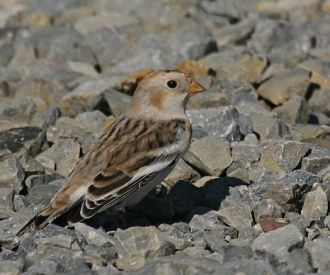 Will species like this snow bunting exist 100 years from now? Right now their future looks bleak.
Will species like this snow bunting exist 100 years from now? Right now their future looks bleak.
Two recent reports have underscored – again – that human actions and climate change are pushing many birds to extinction. This affects not just the birds on remote islands but common species who breed and winter in Pennsylvania. There’s a very real danger that “our” birds won’t be here for our grandchildren to see. It will happen that fast.
Last month in Argentina, BirdLife’s World Conservation Conference met to discuss the prognosis for birds. The grim news is that one in eight bird species are in danger of extinction and common birds around the world are in decline. This comes one year after Audubon published the state of North American birds, a report that highlighted the alarming decline since 1967 of our own common species: Northern Bobwhite down 82%, Eastern Meadowlark -77%, Snow Bunting -64%, Common Grackle -61%.
Then last week the Union of Concerned Scientists reported on how climate change will affect Pennsylvania in the next 100 years. If the process can’t be slowed, it will be bad for both humans and birds: 90-degree days all summer, the loss of cool-climate forest, and a subsequent decline in birds such as ruffed grouse, white-throated sparrow, and magnolia warbler.
Pennsylvania is the 22nd largest producer of carbon dioxide in the world. Because we burn so much coal – and don’t capture the greenhouse gases – our state outranks most countries. Interestingly, this puts the problem in manageable terms. If Pennsylvania makes a change for the better, it will really change the world.
The decline in bird species is so depressing that I usually avoid thinking about it because it makes me so sad. But avoidance doesn’t make it go away. There are things we can do to help – yes, as individuals – and I’ll talk about them in my next blog.
(photo by Chuck Tague)
I have studied the decline and disappearance of some of NYC,s formally common native birds, especially the uncommon nighthawk, of which I have not seen or heard one in the area for over 8 years ! Chimney swifts are down by 70 percent also. It’s devasting to see this.